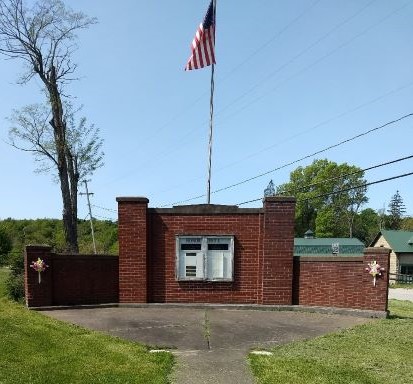Fayette County Historical Society
Family Treasures Saved
Collections and Stories
A Preservation Exhibition
Did you know that one of the last great European royal collections to remain intact is a unique and valuable record of the personal tastes of kings and queens over the past 500 years? How many family treasures do you own that make up a special collection amassed over decades and generations?
The definition of a collection is a group of similar things that you have deliberately acquired, usually over a period of time. If you have three items of the same things, then you have a collection. This is what you will see when you enter the museum you will see collections of bottles, crocks, plates, jars, clothing, quilts, Historical documents, war memorabilia, sports cards and watches.also artifacts from the Green Tree Tavern dig that were excavated by the Mon-Yough Chapter since May 2019.
One of the collections is called "WHO AM I". This is a collection of old photographs of people from the area, but unfortunately their names have been lost to history. We are hoping they can be named by some of our visitors. Along with these pictures, PORTRAITS IN TIME, are pictures of othe groups of people named, as well as individuals. A collection of cameras are als on display that may have been used to take the pictures. There is even some interesting slides from The Odd Fellow Organization.
Hats Off! A collection of hats are displayed along with purses and jewlry.Another collection takes you on a minature tour of doll houses. If you were buying one of those houses in real life you would need to apply for a mortgage, so you may take a look at our banking collection.
Don't Miss This Event. We are hoping to see you on Thursday and Sundays 11;30 to 3;30.
UPCOMING EVENT "A Summer Tea" Please join us on July 20 for a high tea. Reservations are needed. Please call 724-322-3290.
A NEW ADDITION
HADDENVILLE SCHOOL
In response to our expanded role in preserving and promoting Fayette County History, FCHS has recently acquired an additional property. The Fairview School at Haddenville was generously donated to the society by Mrs. Irene (Brown) Mitiska who attended school there and to whose family the property reverted when it was vacated by the Uniontown School District. It is Irene's wish that the school is restored to its original appearance as possible and that it is used to benefit its former students and the public.
The school was sturdily built of brick in 1927 by Alva Walters and features a fireproof basement. The school housed a library and a classroom space on the main floor in which a moveable wall can create two rooms or one expansive room for plays, assemblies, and activities. The children, grades K through 8, ate lunch at their desks and drew water from an outside pump into their collapsible cups.
This building, better known as Haddenville School, sits on a large lot that also holds a Veterans' Honor Roll Memorial.
Although structurally sound, the building will require extensive renovation to accommodate the uses identified by FCHS. In addition to space for exhibits and public events, Haddenville will become an archive and research center. It will be the repository for California University of PA.'s archives for both Ft. Gaddis and the Peter Colley Tavern, two of the earliest structures west of the Allegheny Mountains, and the archives of noted Uniontown author James Fosbrink, and other Fayette historical collections.
To oversee and direct the development of Haddenville, an ad hoc committee has been formed. We sincerely thank Dr. Paul Hartley, Dr. Jean Braun, Dr. Thomas Buckelew, Dr. John Nass, Ron Deems, Vince Karolewics,Joyce Stewart and Bill Zinn for volunteering their time and energies.
Many of the needs are being repaired, including heating and air conditioning, upgraded electrical and internet capability, and ADA Accessible Compliance. As this work is being completed it is the hope of the organization to open the building in 2024.
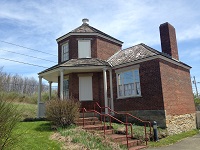
Searights Tollhouse
Watch for open dates
The Searights Tollhouse opened in 1835 and was built because of the National Road. This was the first road built entirely by the Federal government and was commissioned by Congress in 1806, under the administration of Thomas Jefferson, with large support from the Secretary of Treasury, Albert Gallatin and Statesman Henry Clay. The tollhouse is situated at Mile Marker 68 at 7328 National Pike East.
The road started in Cumberland, Maryland in 1811 and was completed to Wheeling, VA, which is now West Virginia, in 1818. To build the road, hills were leveled and huge stones hauled away, trees toppled, underbrush cut back, stumps pulled, and roots grubbed out to make a clearing 66 feet wide. Ditches and culverts were also excavated along the sides of the road for water drainage. The road was covered with measured stones, then covered with sand and gravel.
This road was very important in the development of the United States and was called the National Road and the Cumberland Road, but more affectionately known as the Old Pike. The cost of the road was over $13,000 a mile.
As soon as it was opened a tremendous amount of traffic started to travel the road. Twenty four coaches could be seen at one time, including huge canvas covered freight wagons with large broad wheels which were pulled by six Conestoga horses, which were visible all-day and even into late evening. Drovers with thousand of animals were pushed along on way to market. It was said “looks more like a leading avenue of a great city than a road through a rural countryside.”
With all this traffic and no maintenance, the road began to fall apart. The Federal government, seeing the problem and wanting out of the road business assigned Engineer Richard Dellafield of the Army Corp of Engineers to manage reconstruction of the road and he selected the Macadam System of road building. John MacAdam who came from Scotland was the person that brought this method of road building to the US and it followed the method used for all the roads in England that were built in this fashion. The roadbed was raised above ground level to allow for drainage and to slow erosion. Several layers of crushed stone were laid and compacted by the traffic that rolled over it, creating a solid surface.
Once the road was in good condition it was given to the individual states – Maryland, Pennsylvania, and Virginia. These states were so proud of their newly refurbished road they placed iron obelisk markers every mile of the road from Cumberland to Wheeling.
Tollhouses
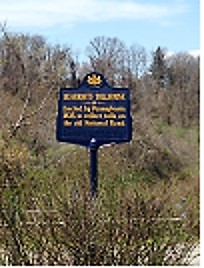
The road necessitated the building of tollhouses to collect fees for the upkeep of the road. Tollhouses were every 15 miles, with two in Maryland and six in Pennsylvania and along the road in Virginia. Most of them were made from bricks, but two were of native cut stone. The Petersburg Tollhouse, also known as Gate Number One in Addison, Pennsylvania was built of stone. It was the first Toll Gate after crossing the Maryland Line into Pennsylvania. The second was the tollhouse located near Fort Necessity, which is no longer standing.
The Searights Tollhouse, also called Gate Number Three, was named for William Searight, a prominent Fayette County resident who was the commissioner of the National Road in Pennsylvania from 1842 to 1845. Searight was later the commissioner of the National Road as well, but only in Fayette County.
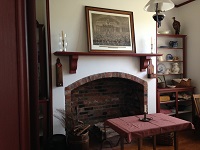
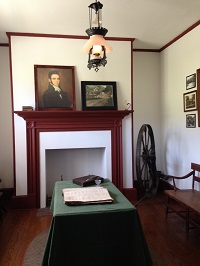
The tollhouses were built with a room above the main room of the building that was used as a bedroom. At one time, the toll keeper for the Petersburg Tollhouse had 2 adults and 13 children using the one bedroom. A very crowded area, but the toll keeper could get a good view of the road and on coming traffic.
Three of the tollhouses are still in existence, our Searights Tollhouse, Addison Tollhouse, and the tollhouse located in LaValle, west of Cumberland, MD.
Great iron gates attached to tall iron obelisk posts were hung at the tollhouses to collect fees for the maintenance of the National Road.These gates were made by William Hatfield, a blacksmith by trade. He served many years as a Justice of the Peace and subsequent to 1855 served a term as Associate Judge.
In the 2023 exhibit at the Abel Colley Museum and you will also learn about people like Thomas Searight, William Hatfield, the Pike Boys, and many others.
William Hatfield
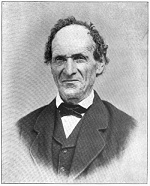
The name turnpike comes from a large pole or pike across the road to stop traffic. As fees were paid, the pike was turned to allow travelers to go through – thus, “turnpike”. If enterprising young people of the National Road, called Pike Boys or others went around the pike, they were known as “pikers”, for they were too cheap to pay the toll.
There is a very interesting story about William Hatfield in a book by Thomas B. Searight of the same family of the tollhouse. The book was written in 1894 about the National Road. Everything and anything you want to know about the National Road is included in this book. The book is called The Old Pike, A History of the National Road, With Incidents,Accidents, and Anecdotes Thereon, and is currently in reprint.

Taverns
Accordingly to Searights’ book there were 294 taverns in a 300 mile span from Baltimore to Wheeling. Taverns were like today’s hotels and motels, from the Hilton to Motel 6, they catered to the very rich and to the very poor. The social standing of the travelers led to a distinction among the taverns. Different classes of people traveled and there was a tavern to fit all needs.
The first type and highest in social standing was the stagecoach tavern catering to the Carriage Trade. Here the traveler could eat, sleep, and drink. These taverns were usually imposing stone or brick buildings. Nearby were large stabling facilities since the stage horses were changed several times a day and teams had to be ready each day.
The next type of tavern accommodated the wagoners, who usually carried their bedding with them and often slept on the tap-room floor. These wagon stands needed large yards for these enormous wagons. The Conestoga wagon, which is built like a ship, was a common sight to the National Road. They hauled manufactured goods from the cities on the Atlantic seaboard to towns and business in the west. These freighters, the 18-wheeler of that time, returned to the east with materials from farms, and products from the mines to keep factories in operation.
Drover stands were for the men who herded sheep, hogs, some horses and cattle to market. You could see 2,000 to 3,000 animals being moved along the National Pike. The places they stayed had large enclosed pens for the livestock to be turned into each night. Hopefully this would prevent them from wandering off, or being killed by larger animals, or not be stolen by rustlers.
Travelers also journeyed by horseback. People were moving west and any shanty or shed that accommodated travelers overnight were included in the count of Searights’ book “The Old Pike”. As you travel Route 40 today there are many of these commodious stage coach taverns still standing.
Comments of the National Road “ the rougher the road and the faster the schedule, the worse the ride.” Passengers in a stage coach would travel 60 to 70 miles a day stopping every 10 to 15 miles for a team of fresh horses. The carriage had steel tires, no springs and seats of hard boards, holding up to six to nine passengers. If the coach was full it would be a better ride.
Past Exhibit Highlights.
Episode Four - David Gilmour Blythe
The David Gilmour Blythe Video is presented by Frank Kurtik. David Blythe was a poet, artist, sculptor, and social critic. Frank tells the story about David's life and time spent in Uniontown, Pa. There is much more about Blythe's life is on display at The Abel Colley's Tavern and Museum.
Episode Four - Part 2 Portraits by David Gilmour Blythe
This video shows portraits by Blythe. This is only a few of his amazing protaits amongst a wide array of paintings, but captures his sense of personal connections to the subjects.
The Green Tree Tavern
One of the past displays at The Abel Colley Tavern and Museum is about the Green Tree Tavern. The tavern was built in the early 1800's and the uncertainty of the original proprietor and the date of the original structure remains a mystery, at some point Abel Colley, son of Peter Colley, owner of the Peter Colley Tavern in Brier Hill, became the owner, expanded the business, and operated the business until the tavern was destroyed by fire sometime prior to 1850. This tavern was located on the National Road between Uniontown and Brownsville. The second part will give insight into the type of meal that would have been served to guests at taverns in Fayette County and this one is representative of The Green Tree Tavern on the National Road. Part 3 gives a closer look at the table with a touch of tavern music, while you enjoy your meal.
Episode Five - The Green Tree Tavern - Part 1
The Green Tree Tavern - Part 2
The Green Tree Tavern - Part 3 - A Tavern Table
The Historical Society would also like to thank the Mon-Yough Chapter who have been undertaking excavation at the Green Tree Tavern site since May 2019 and suppling artifacts for the current exhibit. Excavations will continue at the tavern site starting in May, 2021 and continue until after Labor Day. Volunteers are welcome, as well as visitors. No prior fieldwork experience is required. Also thanks to John Nass, Jr. for including the Fayette County Historical Society's information in the The Mon-Yough Archaeology Chapter #3 - Society for Pennsylvania Archeology 2021 Issue 1 Newsletter.
Below is an aerial view of the excavation of the tavern by members of the Mon-Yough Chapter.
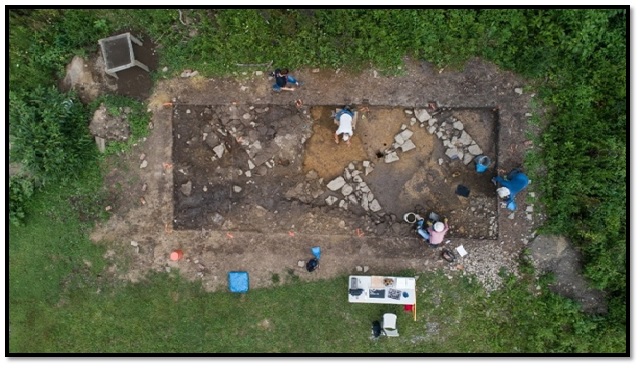
The last exhibit also included The Black Horse Tavern and explained how this tavern played a part in the 1793 Whiskey Rebellion when farmers rebelled against tax collectors to protest a new liquor tax. President George Washington called out the militias to restore order. However, they were talked out of any violent action by Albert Gallatin the owner of Friendship Hill.
Episode Six - The Black Horse Tavern - Part 1
The Black Horse Tavern - Part 2
The Black Horse Tavern - Part 3
The Black Horse Tavern story tells you about the portraits of Jonathan and Mary Ann Sterling who lived in Masontown, Pa. Also, a story about Amelia Matilda Thomas Hook and her husband Peter Hook and why is stands alone in The Black Horse Tavern.
Episode Seven - Amelia Matilda Hook Gorley
Our story today takes us to the Banks of the Monongahela River in Brownsville. A river boat, The Wild Wagoner, has just docked. The video tells a bit about this famous river boat, but the main story is about Amelia and her family. An ordinary person devoted to her family and how their lives touched the lives of many others.
Watch for more videos telling stories about a wide range of people, from the wealthy to the ordinary, from good to evil. See photographs and hear stories of the National Road and how it provided a route through the mountains of the county for settlers heading west. Go to a shipyards in Brownsville on the Monongahela River, which provides for both the domestic and international trade. Below a picture of the Rush Tavern as it once stood on the National Road in Farmington. Photo from "Thomas B. Searight's The Old Pike" by Joseph E. Morse and R.Duff Green published by Green Tree Press in 1971.
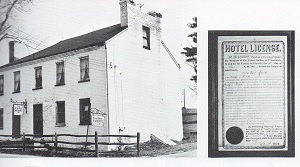
Craig House
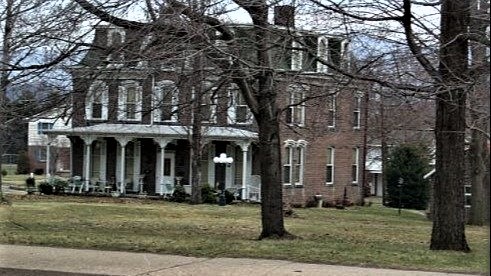
This is a house that deserves a place in history, please save it and the land surrounding it from becoming Dollar General.
Fayette County has a wealth of history and the buildings that tell its story need to be saved and maintained for future generations. The Craig House is certainly one of these remarkable structures that needs to be saved. One must look to the beginning of Fayette County and the people who have passed on before us working to erect such amazing houses.
In 1876, Robert Porter Craig, a descendant of the Honorable John Smile, built a three-story, five bay, Queen Anne brick house, which became known as the Craig House and later the Craig & Sons Farm. Here he lived with his wife, Catherine McCleary Springer and together they had three sons. They raised cattle and grew fruit trees on his hundreds of acres. It has been reported that Robert Craig was inspired to build his home in the style of the southern plantations after visiting the south. His farm won many awards at the Fayette County fairs for its peaches. No one ever had an unkind word to say about Robert and his family.
Robert passed away in 1899; Catherine in 1928. Descendants of the family continued to occupy the homestead until recent years. Current members of the Society and residents of Uniontown remember the many kindnesses of this pioneering family.
To gain a full understanding of Robert Porter Craig and the importance of the Craig House you need to look at Robert’s and Catherine’s heritage. Robert was born in born in Menallen Twp. in 1836 to John Smilie Craig, a farmer, and Jane Springer Craig, whose family owned the Springer farm. He was one of 9 children born to this union.
Robert’s grandmother, Jane Smilie, was the only child of the Honorable John Smilie. Jane married William Craig who was an early pioneer in the iron furnace industry in Fayette County. He was in charge of both the Union and Redstone furnaces before settling in Uniontown. Jane died in 1835 and William in 1838.
The Honorable John Smilie was elected to 8 terms in the U.S. House of Representatives. More importantly, John Smilie, was one of the framers of the U.S. Constitution. Patriot Smilie was born in Ireland in 1741 and came to this country and settled in Fayette County.
When the Revolutionary War began, John Smilie left his Pennsylvania f arm in the care of his wife, Jane Porter Smilie. Once he was elected he became a fierce abolitionist who was instrumental in passing Pennsylvania's anti-slavery law, the first of its kind in the nation. He also took the side of the farmers in the Whiskey Rebellion. Just as his eighth term of office was to begin, he died of typhus fever in 1812 and was buried in the Congressional Cemetery in Washington DC. His wife, Jane Porter Smilie died just a year later.
If you go back in the history of the land that was the home to the Craigs you will find that the Craig house was built on the nexus of two famous Indian trails, the Catawba, running from north to south, and the Nemacolin’s Path, from east to west, crossed this land through the present day Uniontown. The Nemacolin Trail continued in Fayette County to Nemacolin's village (Brownsville) on the Monongahela River at the mouth of Nemacolin's (Dunlap's) Creek Station. Nemacolin's Path was used by many early notables, including Thomas Cresap, Christopher Gist, George Washington, and General Braddock. Braddock's Road followed it closely.
The Catawba Path was also called the Iroquois Main Road. This path was considered a convenient passageway through the Allegheny Mountains and was preferred by the eastern members of the Five Nations: the Mohawks, Oneidas, Onondagas and Cayugas. In 1940 the Great Meadows Chapter of the D.A.R. erected a bronze plaque to mark this historic nexus.Also an interesting fact was that in the 1700's this land belonged to the Reverend Brownfield. Many young lovers traveled to the Reverend's home to be married and for generations it was called "Gretna Green" after the Scottish parish. Gretna Green in Scotland was very important after the 1754 Marriage Act, which prevented couples under the age of 21 marrying in England or Wales without their parents' consent, but was still legal in Scotland to marry without parent consent, hence the name for Reverend Brownfield’s home.
This is a house that deserves a place in history, please save it from becoming a Dollar General.
Information on the trails from HISTORIC INDIAN PATHS OF PENNSYLVANIA and sited by the late Dr. Moss of Circleville
People At Rest
Take a tour of local cemeteries and graveyards, where senators and congressmen are resting. Find out the stories behind some of the most interesting tombstones in the county and some of the forgotten resting places of just ordinary families. The complete list of graveyards and cemeteries will be posted soon. Watch the wedsite for details.
History of the County
Fayette County, carved from Westmoreland County in 1783, was named for the Marquis de Lafayette, the French hero who aided the American colonists in their fight for freedom from England. Early exploration and mapping of the rich forests and fertile valleys of this region was done by Thomas Cresap and Christopher Gist in 1750-51 working with the native Americans . Gist built his home on a large tract of land known as Gist Plantation, near the current site of the Isaac Meason House, a National Historic Landmark near Mt. Braddock. He joined Wendell Brown and sons who had earlier settled in the western part of the county . Gist left the area with George Washington after the defeat at Fort Necessity, but his son Thomas Gist returned and reclaimed their property after the end of the French and Indian War. Other early settlers were Col. William Crawford, also a friend of Washington's, who came to the area in 1765 and built a log cabin where Braddock Road crossed the Youghiogheny River, near Connellsville.
